Publication of Summons
Templates and Forms
Publishing a Notice in the Newspaper When You Can’t Find the Other Party
The procedures described in this Guide apply only to civil cases. If you are attempting to serve documents in a family law case, see the guide on “Service by Publication or Posting – Family Law Cases.”
Related Step-by-Step Guides
When filing a lawsuit, you are required to serve the other party with your summons and complaint, to notify them of the lawsuit. If the other party cannot be located, you will have to ask the court for permission to publish the summons in the newspaper. Publication of summons, as set forth in California Code of Civil Procedure (CCP) § 415.50, is considered a method of last resort. The court can only approve your request for an order for publication of summons if you show that the other party cannot be served in any other manner. You will need to prove to the court that you have made thorough, exhaustive attempts to locate the other party.
Step-by-Step Instructions
1
Search for the Absent Party
The court will require an exhaustive search for the other party before permitting publication of a summons. To conduct an exhaustive search for the other party:
- Try personal service, using the Sheriff or a process server. If using a process server who attempts to locate persons, ask for documentation of their attempts to locate the party.
- Contact all relatives and friends who might know the party’s whereabouts. Keep records of all these contacts, such as a diary detailing telephone calls and copies of letters you send, etc.
- Contact the party’s last known employer.
- Search the telephone directory for the city where the party was last known to live, and attempt contact at any listings that could possibly be the person to be served.
- Check the County Recorder’s and County Tax Assessor’s indexes for the location where the party was last known to live or own real property.
- Check the local jail inmate list and the California Department of Corrections and Rehabilitation inmate locator service.
- Search for the defendant using common, free, search engines.
For more information on locating a person or business, see the guide on “Finding People and Businesses.”
After all these attempts, if you are still unable to locate the other party, you may ask the court for permission for publish your summons in the newspaper.
2
Select a Newspaper for Publishing your Summons
In your application, you must specify the newspaper in which you plan to publish your Summons. This must be a paper of general circulation in the location where the party was last known to reside. A list of newspapers of general circulation in Sacramento County can be found on the court’s website.
If the other party was last known to reside outside Sacramento County, check with the Superior Court in that county. The courts typically maintain a list of all approved newspapers of general circulation in their county. These lists are often available on the court’s website. Links to the websites of each California Superior Court are available at California Courts: “Fine My Court.”
Please be aware that each newspaper is a private company, and the fee to publish the summons is not waived by a court fee waiver. Each newspaper sets its own rate for publication, which can range from $35 to as much as $400.
Each newspaper also has its own policy as to whether the paper files the proof of publication, or whether they give it to you and require you to file it with the court yourself.
2
Obtain Declarations and Supporting Documents
You will need to obtain declarations from anyone else involved in the search for the other party. These declarations in support of your application may be typed or handwritten on Declaration (MC-030), with Attachment to Judicial Council Form (MC-025) attached, if additional pages are needed, or may be typed on 28-line pleading paper, which is available from the Law Library’s website. If you use pleading paper, do not forget to include the declaration under penalty of perjury clause, “I declare under penalty of perjury under the laws of the State of California that the foregoing is true and correct.”
If you had the Sheriff or process server attempt service, ask them to provide documentation of their attempts.
These declarations and supporting documents will be attached to your application as exhibits. See Step 6 for more information.
4
Complete the Necessary Pleadings
Instructions for completing the necessary pleadings are included at the end of this packet. The documents you will need to prepare are:
- Ex Parte Application for Order of Publication of Summons, Points and Authorities, and Declaration in Support of Application for Order for Publication of Summons
- Order for Publication of Summons
If you prefer, you may prepare your Application, Points and Authorities, and Declaration as separate documents, or they may be combined into a single document, as in the case of the template and sample included in this Guide. The Order must always remain a separate document. (California Rule of Court Rule 3.1112). You may download customizable templates of the application and order from the links listed above.
5
Make Photocopies
Make two (2) copies each of:
- Ex Parte Application, including the points and authorities and your supporting declaration
- Any supporting declarations you obtained from others involved in your search (see Step 3)
- Order for Publication of Summons
6
Assemble Your Papers
Assemble your copies into packets for filing. You will have two types of packets.
For each packet type, one packet should include all your original documents; the other two packets should include only photocopies. Staple each set of photocopies, but leave the packets of originals unstapled. The originals will be scanned into the court’s filing system, and the staple will damage the scanner. Put the originals packet at the top of each stack.
Application Packets
Each Application packet will include:
- Ex Parte Application for Order for Publication of Summons, with points and authorities and your declaration in support of your application
- Exhibits, including any supporting declarations or other documentation as described in Step 3 above.
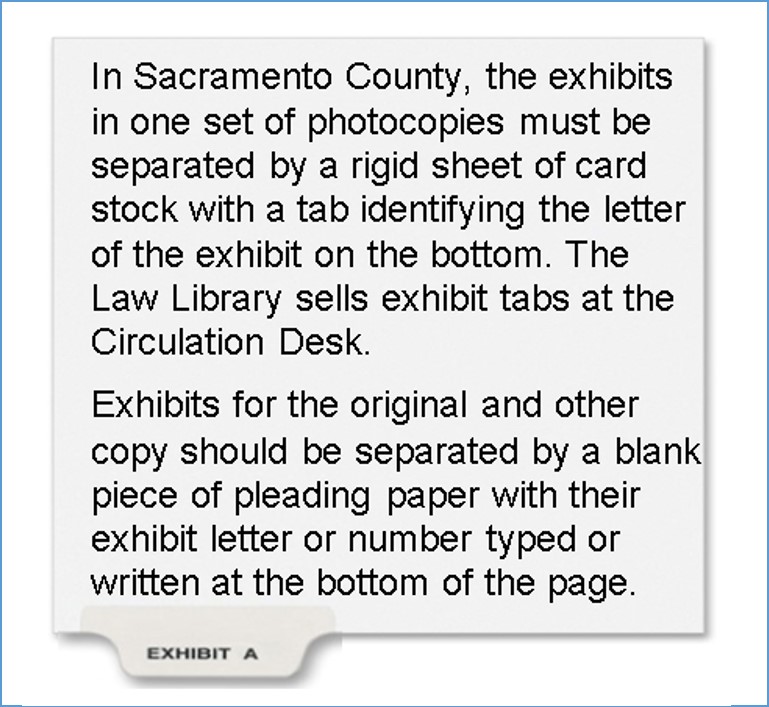
Order Packets
Each Order packet will include:
- Order for Publication of Summons
7
File your Papers
Ex Parte Applications for Order for Publication of Summons are filed at the law and motion civil filing department, Room 212 in the Hall of Justice building at 813 Sixth Street. Fill out and attach the Civil Law and Motion Document Drop-Off Sheet, and date stamp the back of the original packets. Following the instructions posted at the drop box, place the unstapled original document packet plus two (2) photocopies of the packet in the drop box, along with a check or money order for the filing fee, currently $20. Your documents will be forwarded to the law and motion department and will be processed without hearing. Provide the court with a self-addressed stamped envelope to facilitate the return of the order to you.
If your application is granted, the court will mail your signed Order for Publication of Summons to you. If your request is denied, you will receive an order from the court denying your request. Most often the reason a request is denied is because the court does not feel that adequate steps have been taken to attempt to find the person to be served, however the notice will state the reason for denial. If you are able to correct the problems found by the court, such as conducting a more thorough search for the absent party, you may file a new Application.
8
Publish the Summons
Once the court grants the order to publish, your next step is to publish the summons in a newspaper. Even though you are publishing the summons, if you discover the whereabouts of the defendant you should arrange to have that defendant personally served with the summons and complaint.
Submit your summons and signed order to the newspaper you listed in your application.
The newspaper will publish your summons once a week for four weeks, and then provide you with confirmation of publication. Some newspapers will mail you a confirmation, some will have you pick it up, and some will even file it with the court. Contact the newspaper for details.
9
File Your Proof of Publication
If the newspaper does not file proof of publication with the court, you will need to do this yourself. This is a very important step; your case cannot move forward until proof of publication is filed with the court. The proof of publication will include an affidavit or declaration from the publisher listing the dates your summons was published (CCP § 417.10(b)), attached to a copy of the document that appeared in the paper (CCP § 2010). Pursuant to California Government Code § 6064, service is deemed complete on the 29th day after the first date of publication.
9
Next Steps
If the other party has not filed a response 30 days after the effective date for service, you may request a default against the other party. You will then be able to continue your case without the other party’s participation. For more information on your next steps, see the guides “Request a Default Judgment by Clerk” and “Request a Default Judgment by Court.”
If the other party does respond to the lawsuit, your case will move into the discovery phase. There are many procedures available to you during discovery. See Discovery topic page for informational guides and videos..
Samples
Ex Parte Application
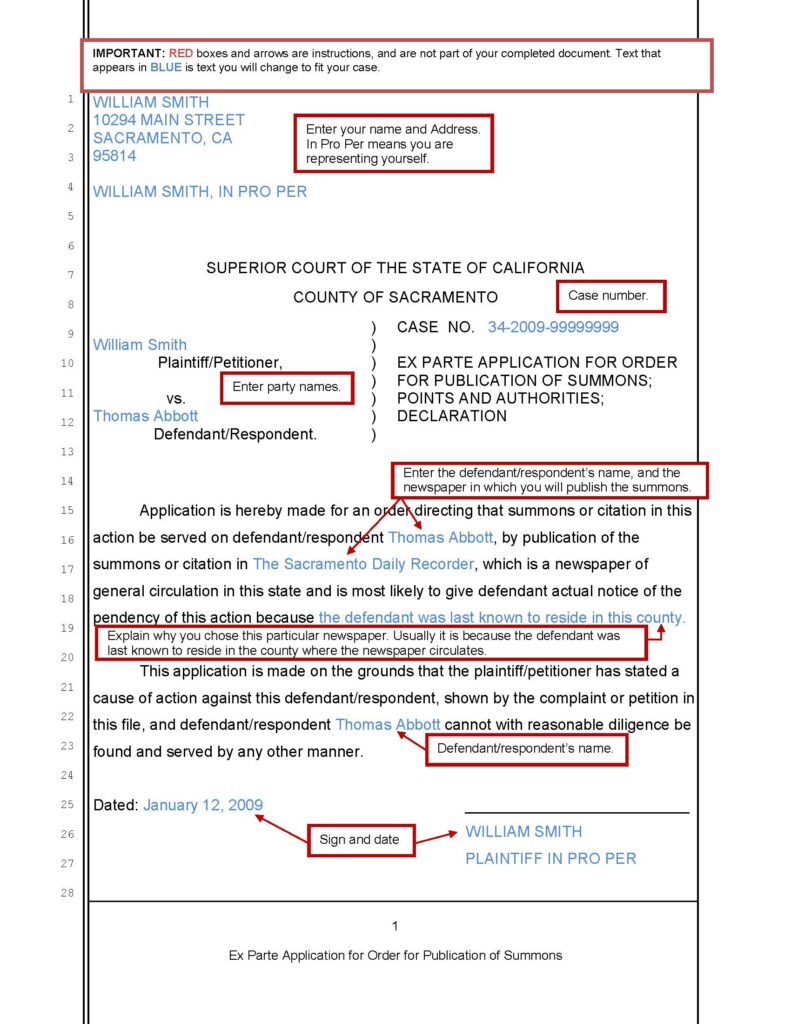
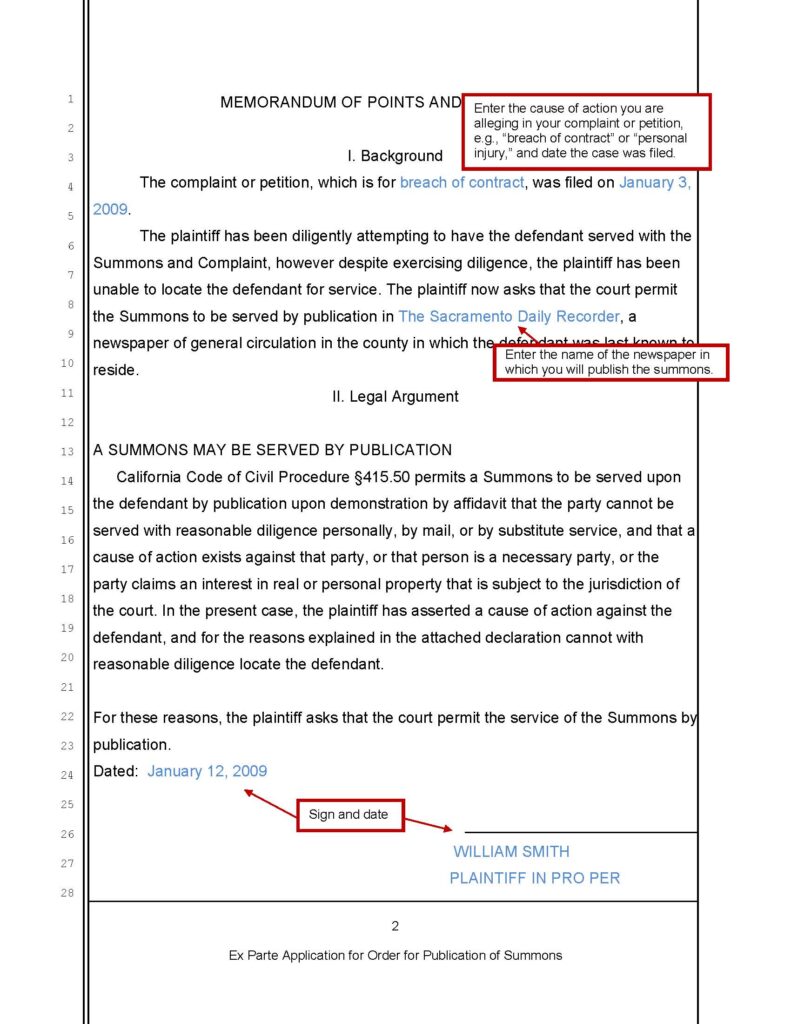
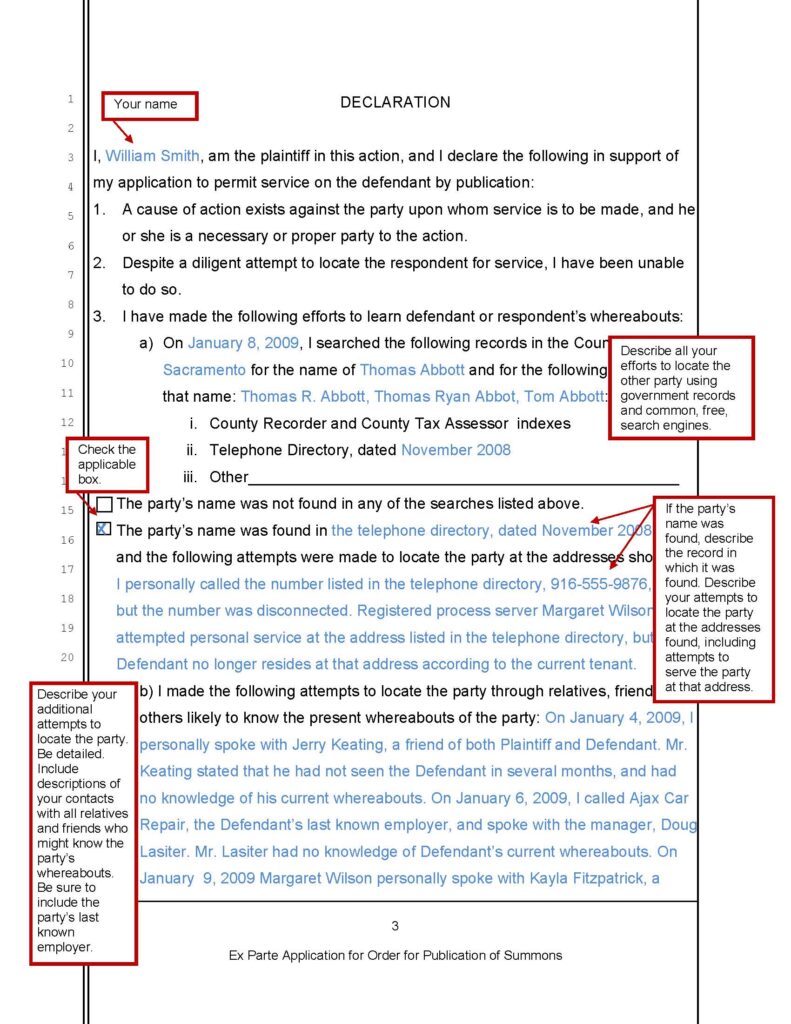
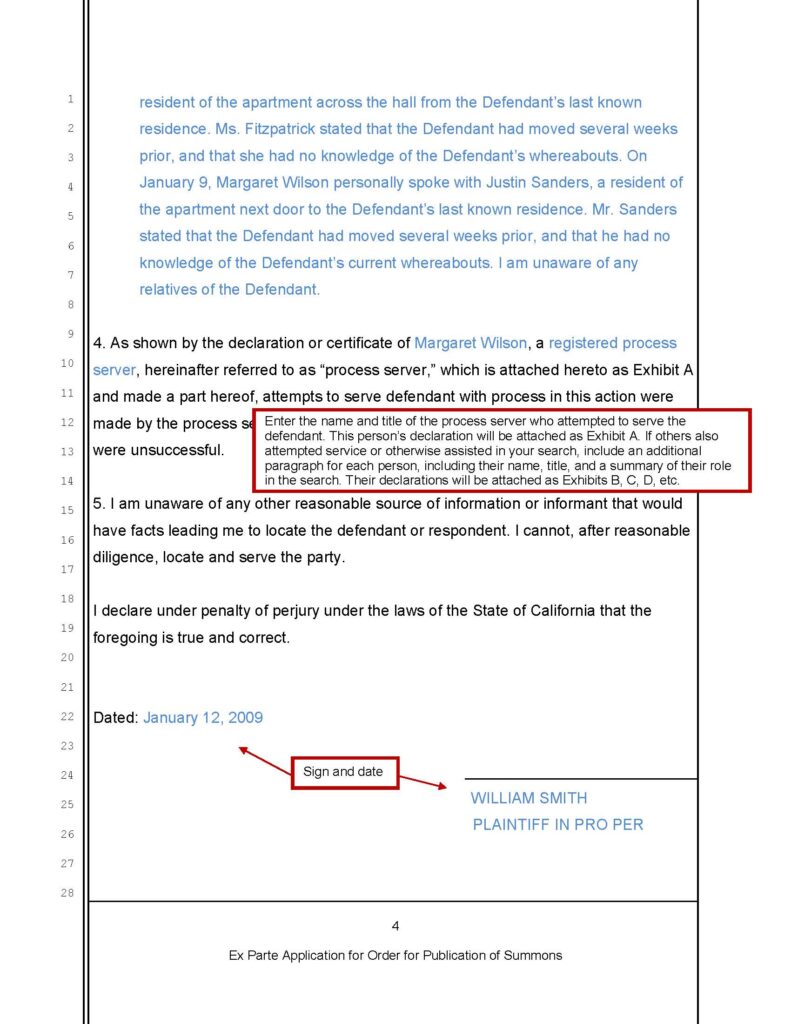

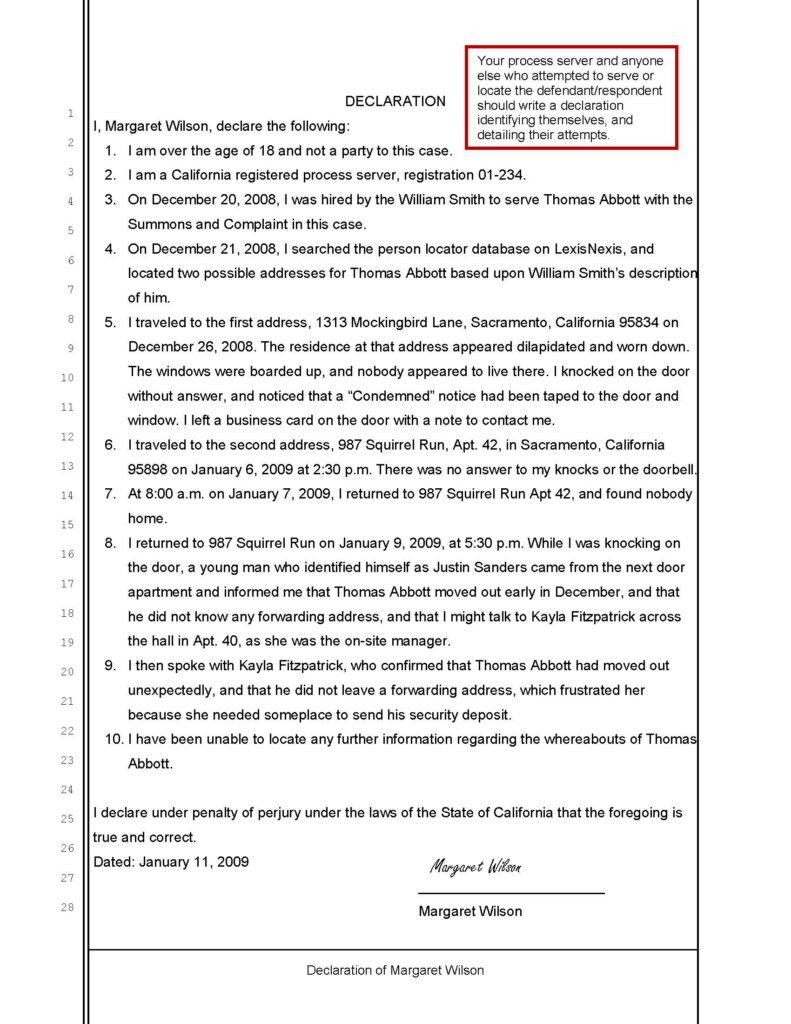
Proposed Order
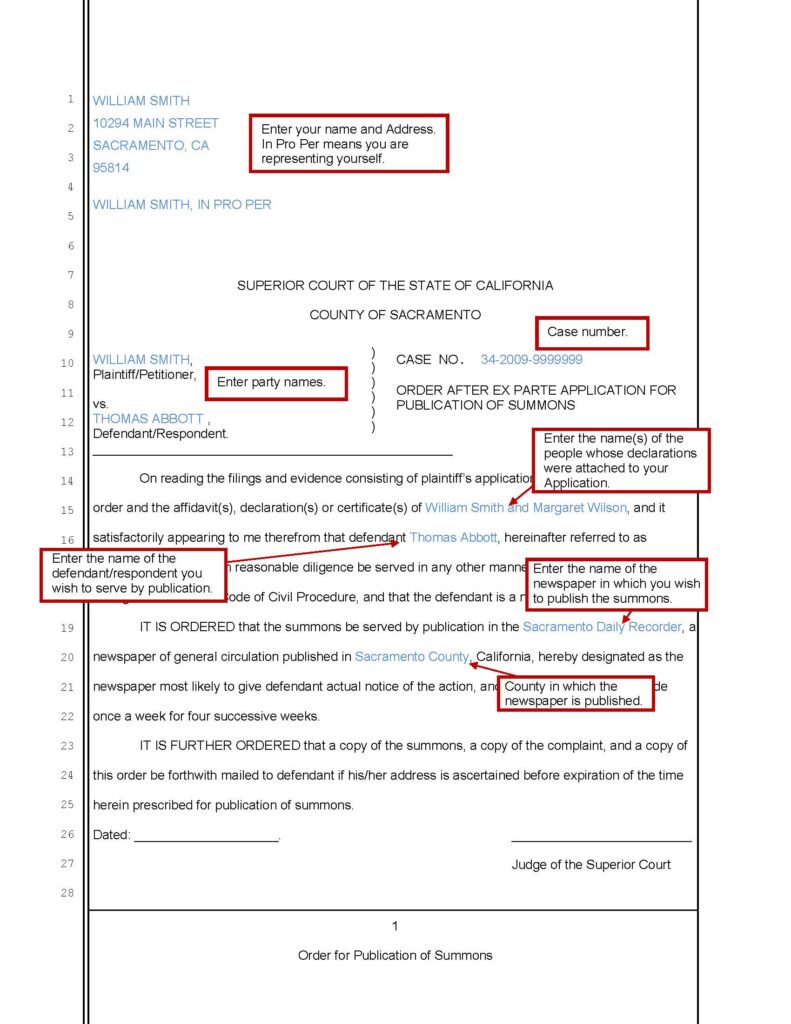
This material is intended as general information only. Your case may have factors requiring different procedures or forms. The information and instructions are provided for use in the Sacramento County Superior Court. Please keep in mind that each court may have different requirements. If you need further assistance consult a lawyer.






